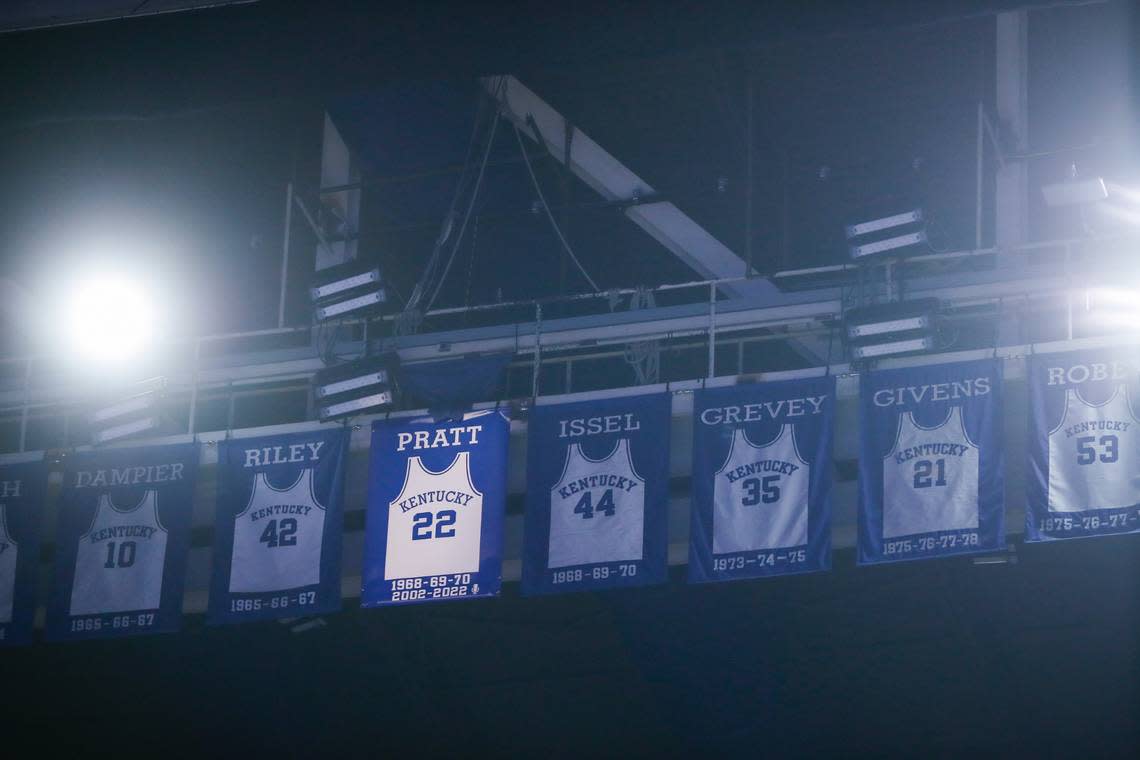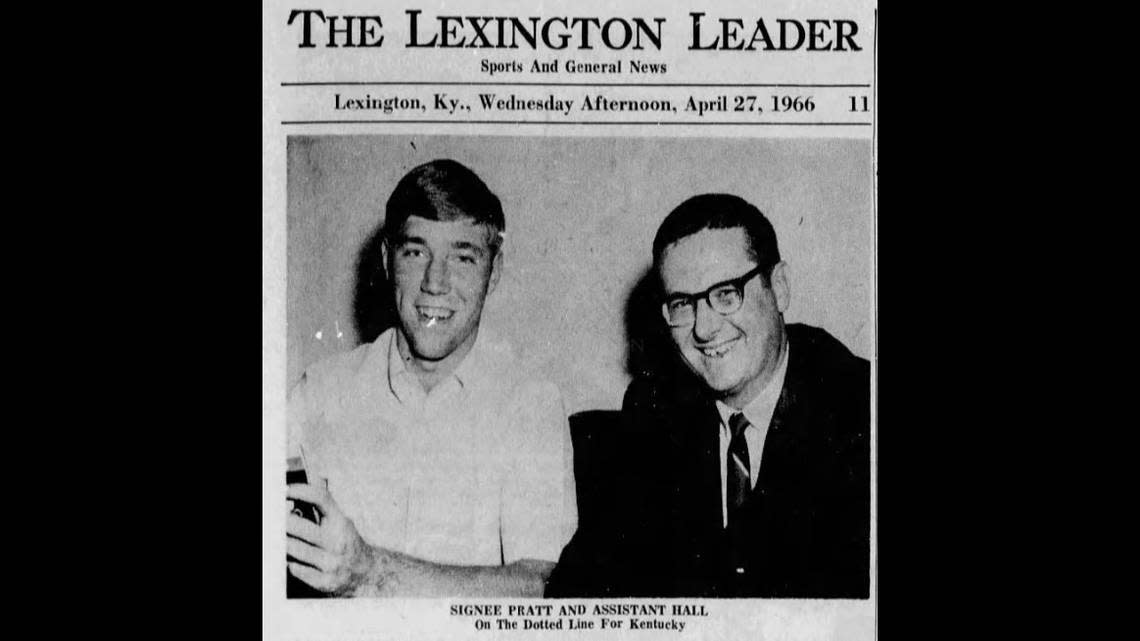From recruit to Rupp’s rafters, more stories and stats on UK basketball great Mike Pratt
When the halftime buzzer sounded in Rupp Arena on Saturday night, there weren’t many Kentucky fans who gave up their seats.
UK basketball great Mike Pratt was honored during the Wildcats’ victory over Florida with a jersey retirement ceremony. A banner with his name and No. 22 now hangs from Rupp’s rafters.
The vast majority of the 20,315 spectators in attendance remained seated at halftime as UK play-by-play announcer Tom Leach emceed the ceremony, which included remarks from Pratt’s wife, Marcia, his former teammate and longtime friend, Dan Issel, and a prerecorded video message from UK Coach John Calipari.
There was a video featuring highlights from Pratt’s playing days as well as calls from his 21 years as UK’s radio analyst alongside Leach — his familiar voice echoing around Rupp as the corresponding shots of Tayshaun Prince, John Wall, Anthony Davis and others played on the video board. Leach ran through his accolades as a player and highlighted his time as a broadcaster. Everyone who spoke mentioned the devotion Pratt had for Kentucky basketball.
“Mike loved his career as a player, as well as a broadcast color analyst,” Marcia Pratt told the crowd. “He was an ambassador in every respect and would consider this recognition the greatest honor of his life.”
Issel, who was Pratt’s teammate from 1967 to 1970, apparently didn’t know until he arrived at Rupp Arena on Saturday night that the No. 22 jersey would be right beside his No. 44 in the rafters.
“I cannot be prouder that he’s right up there next to me,” Issel said, pointing toward the two blue and white banners. “I love it. I love it!”
Pratt died last June at age 73 after a long battle with cancer. When a blue covering was lifted up, revealing his retired jersey, there was a loud ovation from the Kentucky fans. His banner — situated between Pat Riley to the left and Issel to the right — features the seasons he played for the Cats and also notes the 21 years he spent as UK’s radio analyst.
With Pratt’s children and grandchildren on the Rupp Arena court, Issel saluted his late friend.
“On behalf of all of the great players that have played this game here, especially those who preceded Mike in the rafters, I just say: Michael Pratt, you made it, my friend. You made it.”

Recruiting Mike Pratt
One aspect of Pratt’s Kentucky basketball life that stood out to Leach was that his longtime broadcast partner and friend was very much “an Ohio guy” — as he put it — before crossing state lines to play for the Wildcats at age 17.
Pratt was born and raised in Dayton, and there was plenty of good basketball around. Ohio State won the national title six years before he made his college decision (and played in the title game in 1961 and 1962). Cincinnati won the NCAA title in both of those years — ‘61 and ’62 — and the Bearcats were national runners-up in 1963. Dayton was coming off back-to-back Sweet Sixteen appearances when Pratt made his college choice, and the Flyers were national runners-up during his freshman year at Kentucky.
But Joe B. Hall convinced Pratt to leave his home state and come to Kentucky.
Pratt gave his commitment and officially signed with the Wildcats on April 26, 1966. And it was Hall who hand-delivered the papers to the Pratt household in the Dayton suburbs.
Two newspaper reporters and a photographer were in the Pratt basement when Hall arrived with the papers “about three minutes late” from the previously scheduled 7 p.m. commitment time, according to a report in the next afternoon’s Lexington Leader.
“Got it?” the 17-year-old recruit asked the 37-year-old assistant coach.
Hall handed over the letter of intent, and Pratt signed with Kentucky.
The UK assistant turned to Pratt’s mother: “Thank you, Mom Pratt,” he said. “Welcome aboard.”
“All I do is the cooking,” Grace Pratt replied.
Coach Adolph Rupp was unable to be there, but Hall rushed upstairs — with Pratt in tow — to phone him with the good news. A few minutes later, Hall and “a flushed Mike Pratt” returned to the basement. What had Rupp said?
“He said he thinks he’s got another Pat Riley,” Hall replied.
“That’s a pretty big statement,” Pratt said. “I just hope Riley doesn’t make me look too bad in those scrimmages.”

10th commitment
That afternoon’s edition of the Leader also acknowledged that Pratt was the 10th commitment for Kentucky’s 1966 recruiting class. That’s not a typo. And Rupp wasn’t finished yet. The story noted that UK’s head coach figured he would have at least one more available scholarship due to the way the roster was shaping up for future classes. Among the undecided candidates listed for that 11th spot: Dan Issel.
Of course, Issel — a promising post player from Batavia, Ill. — eventually became the 11th commitment for the class of 1966. He explained this week that Phil Argento would end up being the only scholarship player in the class ahead, so Rupp needed bodies in that ’66 group.
“They signed almost the entire all-star team from Kentucky that year,” Issel said.
Ultimately joining Issel and Pratt in the 1970 senior class were Bill Busey of Shelby County High School, Art Laib (who played high school ball in Virginia) and Randy Pool of Tennessee.
In addition to Busey, the 1966 recruiting class featured Kentucky high school standouts Mike Casey (Shelby County), Jim Dinwiddie (Leitchfield), Mort Fraley (Lexington Catholic), Terry Mills (Knox Central), and Benny Spears and Clint Wheeler (both of Ashland).
Casey, Dinwiddie, Mills and Wheeler were all seniors on the 1970-71 team. Fraley ended up at North Texas, and Spears transferred to Morehead State after one varsity season at Kentucky.
Pratt’s stats
Mike Pratt remains one of only two Kentucky players who is ranked in the program’s all-time top 30 in points, rebounds and assists — a testament to the 6-foot-4 forward’s all-around game.
The rebounding stat is especially impressive, given Pratt’s size. With 718 rebounds, he was eighth in program history by the time he left UK and remains 23rd on that list. Pratt also played only three seasons, while 10 of the 22 players ahead of him played four or more.
“He had very strong hands. If he locked onto the ball, he was going to get it,” Issel said. “And, at his size, that’s what helped make him such a great rebounder. He clamped it. … He was a very physical player. And so his ability to rebound and defend at the forward position, for his size, was pretty amazing.”
Issel also said that Pratt wasn’t overly athletic — relative to others at the time — but had a “fundamental soundness” to his game that made him a versatile player.
Asked if he knew the only other UK alum to remain top 30 in points, rebounds and assists, Issel was quick to rule out one name.
“Well, I know I’m not in there,” he said. “My only assists were when the ball fell out of my hands.”
The correct answer is Jack Givens. (Issel, the program’s all-time leader in both points and rebounds, had 98 assists in 83 games.)
Top 40 Club
Pratt is likely to be all alone in that “Top 30 Club” in the near future. Givens is third all-time in points and 12th in rebounds, but he’s No. 30 on the career assists list with 270. The next two-year point guard at UK could pass that up. (Sahvir Wheeler is already in the top 15, for example.)
The list of Cats who are currently in the top 40 in points, rebounds and assists is a little longer. In addition to Givens and Pratt, those versatile former Wildcats are: Keith Bogans, Mike Casey, Chuck Hayes, Scott Padgett and Tayshaun Prince.
All five of those players are relatively close to falling out of the “Top 40 Club.” Prince is 35th in assists, Casey is 37th in rebounds, Padgett is 38th in assists, Bogans is 39th in rebounds, and Hayes is 40th in points.
Rupp’s rafters
Mike Pratt was the 39th player to have his jersey retired in Rupp Arena, and banners for six others — coaches Adolph Rupp, Joe B. Hall, Rick Pitino, Tubby Smith, longtime equipment manager Bill Keightley and revered play-by-play announcer Cawood Ledford — are up there, too.
How does one get a banner in the Rupp rafters?
An individual must first be elected to the UK Athletics Hall of Fame by a committee that consists of media members, current Hall of Famers, campus representatives, current coaches and other athletics department personnel. Five years after being elected to the Hall of Fame, an individual is eligible for jersey retirement, and that honor is considered by a separate committee.
Pratt is the first UK men’s basketball player to have his jersey retired since Tony Delk was honored in 2015. Before that, Sam Bowie (in 2002) had been the most recent player honoree.
Kentucky to the Colonels
Issel and Pratt teamed up with the ABA’s Kentucky Colonels immediately after leaving college. Issel played five seasons with that franchise and another 10 years with Denver. Pratt lasted just two seasons as a pro player — both with the Colonels.
Anyone looking back 50 years at that fact might think Pratt couldn’t cut it as a pro player, said Issel, who explained that wasn’t really the case. According to him, there were two primary reasons Pratt’s pro playing career was so short.
“They tried to make a guard out of him. And small forward was his natural position,” he said. “And then his contract was structured such that a big part of his three-year deal was in the third year, and the third year wasn’t guaranteed. So when he came to training camp in that third year, he basically had no shot to make the team. Because it would cost the Colonels so much money to keep him.”
According to a Courier Journal article before the start of the 1972-73 season, the decision to cut Pratt — just 24 years old at the time — was a “controversial” one.
“Pratt never played a game without leaving a big argument behind,” wrote sports editor Dean Eagle. “His partisans vowed that if coach Joe Mullaney played him more, he would be a pro star.”
The article also quoted Adolph Rupp.
“I’d use Pratt more because he knows how to find Dan Issel with the basketball,” he said.
Pratt had been a role player in his final season with the Colonels — 13.7 minutes per game — but he was fourth in scoring (12.0 points per game) and playing time (28.3 minutes) during the team’s postseason series that year, behind only Issel, Artis Gilmore and Louie Dampier.
“He’s a much better basketball player than I think a lot of people remember,” Issel said.
‘True blue’
Mike and his wife, Marcia Pratt, met later in life — when both were in their 40s, she said — so they didn’t know each other during Mike’s college days. Marcia is an Indiana native and grew up following the home-state Hoosiers, as well as the Louisville Cardinals.
“But not anymore. True Blue!” she declared with a big laugh.
Once she married Pratt, her allegiances — as well as those of her children — changed.
“His love for the university and basketball just sucked my whole family right in,” she said.
Who are the Kentucky basketball greats with jerseys hanging in the Rupp Arena rafters?
Mike Pratt’s jersey to join Rupp rafters. ‘It would have been the highlight of his life.’
Kentucky had some major struggles against Florida. And that was a good thing for the Cats.
